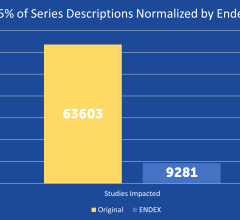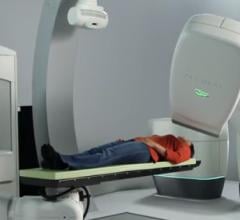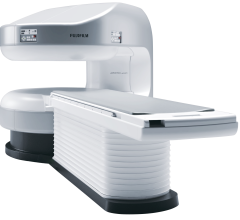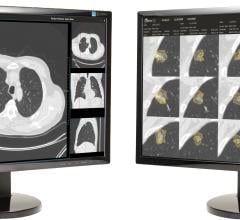Scranton Gillette Communications’ Imaging Technology News (ITN) was recently named a 2017 Azbee Award winner in two Upper Midwest Regional categories. The annual Azbee Awards are hosted by the American Society of Business Publication Editors (ASBPE) to recognize editorial and design excellence in the business, trade and specialty press.
May 11, 2017 — Accuray Inc. announced that studies on the clinical use of the CyberKnife System continue to demonstrate ...
A large nuclear cardiology laboratory in Missouri has slashed its average radiation dose by 60 percent in eight years, according to new research presented at ICNC 2017, May 7-9 in Vienna, Austria and published in JACC:Cardiovascular Imaging.1,2 The study in over 18,000 patients showed dose reductions were achieved despite a large number of obese patients.
Fujifilm’s APERTO Lucent is a 0.4T mid-field, open MRI system addressing today’s capability and image quality needs ...
According to new research by the Harvey L. Neiman Health Policy Institute, the use of follow-up imaging is significantly less when initial emergency department (ED) ultrasound examinations are interpreted by a radiologist than a nonradiologist. The study is published online in the Journal of the American College of Radiology (JACR).
Breast cancer is one of the leading causes of death of women worldwide. In Canada, according to the Canadian Cancer Society, one in every nine women is expected to develop breast cancer in her lifetime, and one in thirty will die from it.

SPONSORED CONTENT — Fujifilm’s latest CT technology brings exceptional image quality to a compact and user- and patient ...
McKesson Imaging & Workflow Solutions, an industry leader in providing healthcare IT and imaging solutions, is pleased to announce that independent research firm KLAS has named McKesson Radiology a Category Leader in the 2017 Best in KLAS: Software & Services report for the Picture Archiving and Communications Solutions (PACS) (Community Hospital) segment, ranking number-one in the market segment.
SPONSORED CONTENT — Fujifilm’s latest CT technology brings exceptional image quality to a compact and user- and patient ...
Philips' mission is to build intuitive, scalable and customizable products that can be easily adapted to customers' needs. This approach is the foundation for the new Philips IntelliSpace Enterprise Edition.
Philips announced the debut of its TrueVue, GlassVue and aRevealA.I. capabilities on the company’s Epiq 7 and 5 and Affiniti 70 and 50 ultrasound systems. The new visualization tools work together to enable photorealistic, transparent and 3-D visualization in one touch, delivering more reproducible and lifelike ultrasound images than traditional technologies.
For a brief time — from the mid-1980s to mid-1990s — teleradiology was exemplified by camera-on-a-stick technology. It was a simple set up: a lightbox lying flat on a table illuminate radiographs; a digital camera with a zoom lens suspended above, usually by a wire frame, takes pictures; a desktop PC records and transmits them over a modem.
SPONSORED CONTENT — EnsightTM 2.0 is the newest version of Enlitic’s data standardization software framework. Ensight is ...
May 9, 2017 — More than 100 radiation oncologists from across the United States took to Capitol Hill last week urging ...
Management consulting firm Booz Allen Hamilton and data science company Kaggle recently announced the winners of the third annual Data Science Bowl, a competition that harnesses the power of data science and crowdsourcing to tackle some of the world’s toughest problems. This year’s challenge brought together nearly 10,000 participants from across the world. Collectively they spent more than an estimated 150,000 hours and submitted nearly 18,000 algorithms — all aiming to help medical professionals detect lung cancer earlier and with better accuracy.
May 5, 2017 — Kubtec announced that its contract to be a supplier to Vizient Inc. is now active. Under the terms of ...
Did you know that approximately one-third of all the data in world is created by the healthcare industry and that ...
IBA announced that building works have begun on the Proton Therapy Center ParTICLe – Belgium’s first center for proton therapy. ParTICLe, short for Particle Therapy Interuniversity Center Leuven, is a clinical and scientific collaboration between five university hospitals.
The term mesothelioma was coined in 1909, just a few years after the introduction of medical X-ray imaging. The term was ...

SPONSORED CONTENT — EnsightTM 2.0 is the newest version of Enlitic’s data standardization software framework. Ensight is ...
A trend that has already taken shape in other industries now may be on the cusp of radiology. Tuned to exactly fit their users’ desires, mobile devices — purchased by their users — promise to display medical images anywhere at any time and at a moment’s notice. They are part of a broad-based bring your own device (BYOD) trend. And the BYOD most likely to have an impact is the iPad.
Over the last decade, the impact of dense fibroglandular breast tissue on breast cancer screening has become a prominent topic of national conversation among those fighting the disease. Screening is the first line of defense for patients, and the realization that their mammography results may not be accurate has caused concern. While mammography remains the gold standard for breast cancer detection and diagnosis, the “one-size-fits-all” approach of years past has evolved as patients and providers drive toward more personalized screening programs. While several technologies and other new developments have propelled this idea forward, automated breast ultrasound (ABUS) has gone a long way toward cementing the idea of patient-specific breast cancer screening protocols and programs.
The radiology landscape is pocked with cyber mines. And it’s getting worse. Legacy imaging systems are connected to picture archiving and communication systems (PACS), which are being linked to electronic medical record (EMR) systems and best of breed IT systems, as hospitals increasingly move to enterprise imaging. These make tempting targets for hackers. And the worsening situation is being caused by the best intentions.
Bethesda Health in southwest Florida has leveraged its picture archiving and communication system (PACS) to improve medical imaging workflow and efficiency. This has led to cost savings, shortened turnaround times (TAT) and improved analytics to enable better business management. Bethesda Health is based in Boynton, Fla., and includes Bethesda Hospital East and West hospitals with a total of 481 beds, plus the Bethesda Health Urgent Care.
The implementation of electronic health records (EHR) has created an expectation that all patient data, including images, should be available in one location. Today, reports describing images are not enough, as many referring physicians want to see the images, and many use them to help guide therapies. This has caused an increased demand to exchange medical images in the various departments of healthcare settings.
The continuum of personalized care, covering individualized prevention and therapy, translates into multiple changes to patient data sources. One of the primary sources is medical imaging that evolves into various multimodalities, allowing simultaneous acquisition of clinical images. Positron emission tomography/computed tomography (PET/CT) systems have been around for more than a decade, and now PET/magnetic resonance imaging (MRI) scanners are working to reach the market.


 May 11, 2017
May 11, 2017 



















